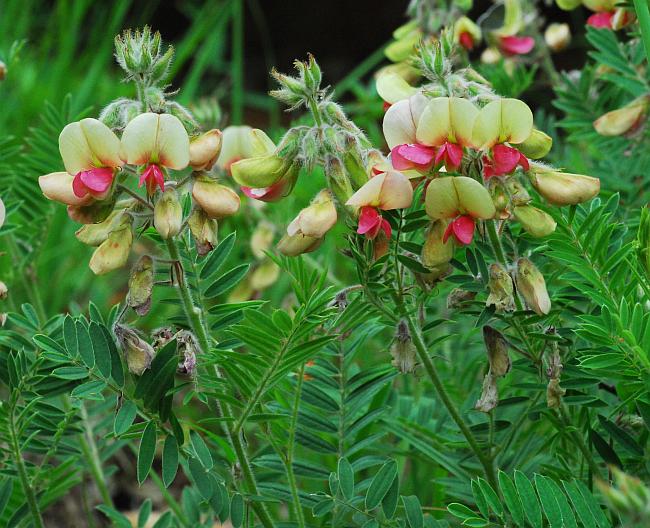Tephrosia virginiana (L.) Pers.
Goat's Rue

Native
CC = 5
CW = 5
MOC = 71
© SRTurner
Tephrosia virginiana (L.) Pers.Goat's Rue | |
 |
Native CC = 5 CW = 5 MOC = 71 |
© SRTurner |
|
Family - Fabaceae/Faboideae Habit - Perennial forb with long, woody roots and/or rhizomes below a thick, knobby caudex. Stems - Ascending to erect, to 50 cm, multiple from base, often clustered, appearing unbranched above the base, unarmed, moderately to more commonly densely pubescent with fine, appressed and spreading hairs.
Leaves - Alternate, odd-pinnate with 13-25 leaflets, the petiole 1-2 mm long, the rachis 4-12 cm long. Stipules 7-11 mm long, narrowly elliptic or lanceolate to linear, those of the upper leaves sometimes hairlike, often shed early; stipels absent. Leaflets 12-30 mm long, 2-10 mm wide, narrowly elliptic to oblanceolate, narrowly oblong, or linear, angled to rounded at the base, angled to a bluntly or sharply pointed tip, the terminal leaflet sometimes rounded or shallowly notched, the midvein often extended into a mucro, the margins entire, glabrous or more commonly ascending-hairy, the upper surfaces glabrous or moderately to densely pubescent with short, fine, curved hairs, the undersurface densely appressed-hairy and with noticeable lateral veins.
Inflorescence - Terminal compact racemes of 12-40 flowers, the stalk 1-3 cm long, the bracts 5-12 mm long, hairy, linear to hairlike, withering but usually persistent; bractlets absent, the flower stalks 4-20 mm long.to -10cm long (tall). Pedicels to 1cm long in flower, hirsute to densely villous. Each flower subtended by a bract to +1cm long.
Flowers - Calyces with the tube 2-5 mm long, bell-shaped, densely hairy, 2-lipped, the upper 2 lobes 3-6 mm long, fused toward the base, the free portions long-tapered above a sometimes short, triangular base, the lower lip with the lateral lobes similar in length to the upper ones, the lowermost lobe 4-7 mm long, narrowly oblong-triangular. Corollas papilionaceous, bicolorous, the banner 15-19 mm long, 12-18 mm wide, the expanded portion nearly circular to broadly kidney-shaped, broadly pointed to rounded or slightly and broadly notched at the tip, keeled longitudinally, bent upward abruptly toward the base, the outer surface hairy, green when young, turning yellow to cream-colored at maturity, the inner surface white to cream-colored with a pinkish-tinged region surrounding a greenish yellow patch near the base, the wings 12-20 mm long, 5-7 mm wide, oblong-obovate, rounded at the tips, somewhat angled over the keel, rosy pink, the keel 12-15 mm long, 5-7 mm wide, boat-shaped, curved upward, rounded to bluntly pointed at the tip, light pink to light yellow with pinkish tinging or lines. Stamens 10, 9 of the filaments fused and 1 free to below the midpoint, the fused portion 8-11 mm long, the free portion 2-4 mm long, curved upward and with the filaments often broadened toward their tips, the anthers small, attached at the base, all similar in size, yellow. Ovary 8-10 mm long, densely hairy, with a collar-like nectary at the base, the style 8-11 mm long, hairy on the inner side, curved, the stigma terminal, minute.
Fruits - Legumes 3-5 cm long, 3-6 mm wide, narrowly oblong, flattened, straight to slightly curved, tapered asymmetrically at the tip to a slender, often curved beak, the surfaces papery, brown, sparsely to densely hairy, dehiscing by 2 valves, these straw-colored to brown at maturity, usually twisting spirally after dehiscence, 6-11-seeded. Seeds 3.0-4.5 mm long, kidney-shaped to more or less oblong in outline, flattened, the surface greenish brown to brown, often mottled with black, smooth, somewhat shiny.
Flowering - May - July. Habitat - Upland prairies, sand prairies, savannas, glades, dry upland forests, tops of bluffs, fields, railroads, and roadsides; often on acidic substrates. Origin - Native to the U.S. Lookalikes - Vegetatively similar to Amorpha canescens. Other info. - This attractive and distinctive plant is found throughout Missouri except for the northwestern corner of the state. It occurs throughout most of the eastern half of the continental U.S. When in flower the plant is unmistakable due to its striking, two-colored bean pattern flowers. It is not hard to identify vegetatively from its pinnately divided foliage which appears gray (canescent) from hairiness. The appearance of the leaves is similar to those of Amorpha canescens, which occupies similar habitats. The two can be reliably distinguished by the shape of the leaflets. In Tephrosia virginiana the leaflet bases are tapered, whereas in A. canescens the leaflets are truncate to slightly cordate at the base. Photographs taken at the Current River Conservation Area, Reynolds County, MO., 6-13-01, and in Alley Spring, MO., 6-3-03 (DETenaglia); also at Shaw Nature Reserve, Franklin County, MO, 6-3-2007 and 6-13-2019, Ha Ha Tonka State Park, Camden County, MO, 6-2-2012, Barton fen, Iron County, MO, 6-16-2013, Onondaga Cave State Park, Crawford County, MO, 6-12-2014, and Barn Hollow Natural Area, Texas County, MO, 6-4-2017 (SRTurner). |